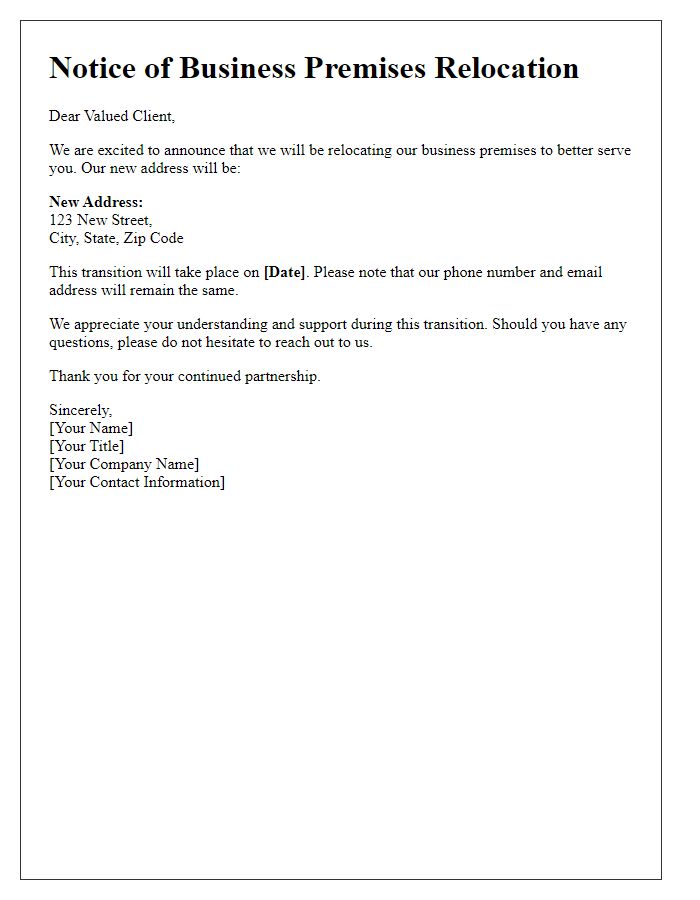Are you considering relocating your business premises? Moving can be a daunting task, but it also presents exciting opportunities for growth and innovation. In this article, we'll cover essential tips and a handy letter template to seamlessly communicate your relocation to clients and stakeholders. Join us as we explore how to make your transition as smooth as possibleâread on to discover valuable insights!

Company header and contact information
The relocation of business premises can significantly impact operational efficiency and employee productivity. A well-planned move to a new facility, such as a modern office building or an industrial warehouse, offers opportunities for improved layout and updated resources. Notable locations, like downtown business districts or suburban commercial hubs, can enhance visibility and accessibility, attracting more clients and talent. Addressing logistical considerations, such as transportation routes and moving timelines, is crucial to minimize downtime. Additionally, effectively communicating the change to employees, clients, and stakeholders ensures a smooth transition and maintains ongoing relationships.
Announcement of new address with effective date
Effective October 15, 2023, our company will be relocating to a new address. The new premises located at 123 Main Street, Suite 400, Springfield, IL, present an opportunity for growth and improved services. This transition will enhance our operational capabilities, featuring upgraded facilities and enhanced technology to better serve our clients. All correspondence and visits will need to be directed to the new location from this date onward. We appreciate your support and look forward to continuing our relationship from our new home.
Reason for relocation (optional)
Relocating business premises offers opportunities to enhance operational efficiency and improve customer engagement. Factors such as increased space demand, declining foot traffic in the current location, or a strategic decision to move closer to a target market can drive this change. A more accessible location, like a bustling urban area or a growing suburban region, can attract a diverse clientele and facilitate better supply chain logistics. Additionally, modern facilities can provide essential upgrades, such as improved technology infrastructure and sustainable energy solutions, enhancing both employee productivity and overall business performance.
Impact on services or operations
Relocating business premises can significantly impact services and operations. Disruption during the moving process may result in delayed deliveries (up to several weeks depending on logistics providers), affecting supply chain efficiency. Employees may experience temporary accessibility issues (such as increased commuting time due to new location within city limits or change in public transport routes). Additionally, client interactions may suffer during the transition, as communication lines can become less stable or inconsistent (specifically telephone and internet services, which could disrupt client support). Equipment such as servers or point-of-sale systems may also face downtime during the physical move (potentially ranging from hours to days depending on complexity). Planning for contingencies becomes crucial to mitigate these effects and maintain operational continuity.
Contact information for inquiries and support
The relocation of business premises can impact customer communication and support channels. Updated contact information is essential for maintaining effective operations during this transition process. New address details, including street name, number, city, and zip code, should be clearly noted to prevent confusion. Telephone numbers and email addresses must also be updated across all platforms, ensuring they match the new location. Customers should receive notifications via newsletters or website announcements, detailing the reasons for the move and the effective date of the changes. Additionally, providing dedicated support hours during the transition period can enhance customer experience and foster continued trust in services offered.
Letter Template For Business Premises Relocation Samples
Letter template of business premises relocation announcement to employees

Letter template of business premises relocation communication to stakeholders

Letter template of business premises relocation invitation to open house

Letter template of business premises relocation confirmation for lease agreement

Letter template of business premises relocation advisory for service interruptions

Letter template of business premises relocation details for local authorities

Letter template of business premises relocation gratitude note to patrons







Comments